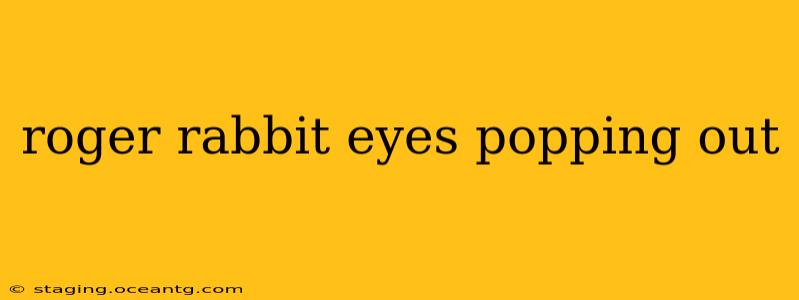Roger Rabbit's comically bulging eyes are arguably one of the most memorable aspects of Who Framed Roger Rabbit. This seemingly simple animation technique plays a crucial role in establishing the character's personality and contributes significantly to the film's overall comedic effect. But how was it achieved, and why is it so impactful? Let's explore the magic behind Roger's expressive peepers.
How Were Roger Rabbit's Popping Eyes Achieved?
This effect wasn't created through simple 2D animation. The film's groundbreaking use of a technique called live-action/animation compositing was key. Instead of traditional cartoon methods, Roger's eyes, and indeed the entire character, were created through a combination of live-action filming and detailed animation. The animators meticulously crafted Roger's expressions, and then these animated elements were seamlessly integrated with the live-action footage. For the popping eyes specifically, a clever combination of animation and potentially even practical effects (depending on the specific shot) would have been employed. Imagine separate layers of animation for the eyeballs themselves, allowing for independent movement and exaggeration.
Why Are Roger Rabbit's Eyes So Effective?
The success of Roger's popping eyes lies in their exaggeration and timing. The animation isn't just about the eyes physically moving; it's about the way they move. The timing and the degree of exaggeration are carefully calibrated to enhance the comedic effect of the scene. The unexpected bulge of his eyes often mirrors his surprise, fear, or other extreme emotions, amplifying the humor. This exaggeration, while extreme, remains grounded in a believable character performance. It's not just random eye movement; it's carefully choreographed to enhance the narrative.
Were there different techniques used for different scenes?
The exact techniques used varied from scene to scene depending on the complexity of the animation and the specific expression required. Some shots might have relied more heavily on the animation itself, while others might have involved slight physical adjustments to the model during the live-action shoot, which was then enhanced through compositing. The process was intricate and involved a significant collaborative effort between the animation and live-action teams.
What makes Roger Rabbit's animation style unique?
Roger Rabbit's animation style distinguishes itself through its blend of traditional animation techniques with the innovative use of live-action compositing. The seamless integration of cartoon characters into a live-action environment was groundbreaking for its time and required significant technical innovation. This unique approach allowed for a level of realism and emotional expression rarely seen in animation before.
What impact did Roger Rabbit's visual style have on animation?
The groundbreaking animation techniques used in Who Framed Roger Rabbit have had a lasting impact on the animation industry. The film helped pave the way for more sophisticated compositing techniques and inspired other filmmakers to explore the possibilities of integrating animation and live-action in innovative ways.
What other characters utilize similarly expressive eyes in animation?
While Roger Rabbit's eyes hold a special place in animation history due to the innovative techniques used to create them, many other cartoon characters utilize expressive eyes to convey emotion. Think of the wide-eyed wonder of characters like Mickey Mouse or the expressive blinks of Bugs Bunny. However, Roger's eyes hold a distinct quality because of their exaggerated movement and the technical marvel behind their creation.
In conclusion, Roger Rabbit's eyes are more than just a visual element; they are a testament to the power of animation and a symbol of the film's innovative spirit. The masterful combination of animation and live-action techniques, coupled with precise timing and exaggeration, created a character whose expressive eyes remain instantly recognizable and incredibly effective to this day.
